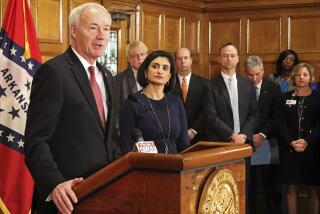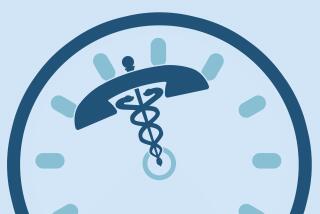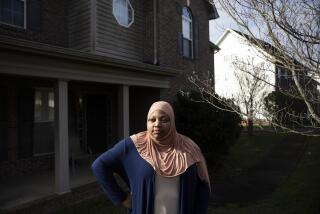Ailing Poor in N.Y. Have Little Choice Except to Turn to ‘Medicaid Mills’
- Share via
NEW YORK — The lines begin at sunrise, often before the metal gates have been lifted from a single shop window in Harlem or the Bronx.
Patients arrive by the dozen, limping and wheezing, many clutching Medicaid cards. Some, such as Melissa Mendez, a 26-year-old mother of four, will stand for hours, fevered and coughing, outside a bleak South Bronx office building. Others nap on crumpled pads of cardboard, or fashion makeshift chairs from the seats of abandoned cars.
The street is their waiting room, because there is almost never a place to sit inside the dilapidated doctors’ offices known as “Medicaid mills.” Such places have gained prominence here as funds for public health clinics disappear and the poor overwhelm hospital emergency rooms.
Housed in shabby, nondescript storefronts along the most desolate blocks in the city, the clinics are called mills because, for the official New York State Medicaid reimbursement rate of about $11 per patient visit, doctors there grind routinely through dozens of patients in a single hour. Often, exams consist of nothing more than taking a person’s name, temperature and Medicaid information.
“You can’t call what goes on in those places medicine,” said Joseph Post, medical coordinator for the state Health Department’s office of professional conduct, which investigates Medicaid abuse. “It’s a continuous obscenity. . . . No real doctor would spend a day there.”
Medicaid, the primary health plan for the poor, has become by far the fastest-growing spending program in the United States, costing federal and state governments more than $90 billion this year.
But with fees that lag far behind what private insurers or even Medicare pay for the same services, many of even the most committed doctors refuse to participate in Medicaid.
Local law-enforcement officials have intensified their scrutiny of these operations, where doctors often prescribe drugs that are sold immediately on the street or back to the supplying pharmacies--usually owned by the same person who owns the mill. Enforcement officials and legislators say that, like crack houses or brothels, as soon as one mill is shut, another opens around the corner.
Several recent visits to one such doctor’s office, on East 138th Street in the South Bronx, revealed long lines of young men waiting to enter, then staying for only a moment or two. Most then proceeded to the pharmacy next door. When finished there, several crossed the street and climbed into an abandoned building through a hole in a bricked-up window.
“Crack house,” said a sergeant at the nearest police precinct. “They go from the doctor to the pharmacy, get whatever they can and try to barter it away for crack. It’s absolutely routine.”
Most Medicaid mills are run by people who never appear on the premises, according to state fraud investigators. With no sign outside, or simply the words “Doctor’s Office” painted above their doors, the offices consist of a waiting area, desk and examination room. Medical equipment is sparse, usually nothing more than a machine to test hearing and another to test lung capacity.
“They are installed only for the revenue they bring in,” said Post, a retired physician who investigates claims of abuse for the state. “They advertise for doctors in the newspaper help-wanted ads. Most are newly licensed immigrants, eager for the money and often unaware that the conditions are so profoundly unacceptable.”
The doctors earn a salary of as much as $5,000 a week for fewer than 40 hours of work.
No matter what the malady, a visit to a mill rarely lasts more than a minute or two, time enough for a cursory examination and to draw blood for a series of expensive tests. The blood will be sent to a lab that will reward the Medicaid mill with a small fee for the favor. The same is true for pharmaceuticals. Since the government pays for Medicaid drugs, and kickbacks are routine, few patients depart without prescriptions.
Mendez said she came to the mill near her home in the Bronx on a recent morning only because the emergency room at the Lincoln Hospital Center usually is so overcrowded that she could not wait. Still, she stood in line at the mill with two of her four children for two hours, waiting to see a doctor for a severe respiratory infection. Three minutes after she finally entered, she came out with prescriptions for three popular and expensive drugs.
The drugs, given to many patients at this clinic, were Naprosyn, Tagamet and Proventil. Naprosyn is an anti-inflammatory drug that can cause internal bleeding. Tagamet is used for ulcers or the type of bleeding that can be caused by improper or extensive use of Naprosyn. Proventil has been highly successful in treating asthma.
“(The doctor) took my temperature and gave me blood tests,” she said. “She really checked me out.”
But many health professionals say it is not possible to receive real care--good or bad--in such a brief visit. Mill doctors rarely bother to learn results of the tests they order for patients. Even when they do receive test results from the labs, state investigators say, the doctors frequently fail to inform patients of abnormal findings.
New York state does not release records of Medicaid investigations, but several case studies were made available by the House Government Operations subcommittee on human resources and intergovernmental relations, whose chairman, Rep. Ted Weiss (D-N.Y.), has held hearings on the quality of Medicaid physicians in the poorest urban areas.
The pictures that emerge from these reports are similar. “All patients made only one visit,” said a typical state Health Department study on Robert Rozefort, a New York doctor excluded from the Medicaid program last year after a lengthy review. “Histories were illegible, no real records, or exams. There were no lab tests ordered or recorded, nor were diagnoses validated,” which means there was no continuity in the charts, nor were there second visits to make certain that initial diagnoses were correct.
“There is a monotonous quality to these charts,” the study said. “Eight of 10 patients complain of asthma, and five of 10 complain of back pains. Almost all were given Tagamet and Proventil for uninvestigated complaints. These drugs potentiate the effects of cocaine. This is grossly substandard care.”
Rozefort could not be reached for comment. Although the state decided to withdraw permission for him to receive Medicaid reimbursement, no other action was taken.
Because of the welter of licensing regulations and a cumbersome appeals process, attempts to remove physicians from the Medicaid program can take years. Any licensed doctor may treat Medicaid patients; physicians are free to take a few patients, many or none.
The wide disparity in fees discourages many competent and reputable doctors from treating those often most in need of basic care. Many reports have shown the sharp statistical relationship between low-income and perilously bad health care. Yet, in its most recent report to Congress, the Physician Payment Review Commission found that 44 states have severe problems finding doctors willing to participate in the Medicaid program. Low fees were cited as the reason in almost every case.
In New York, whose Medicaid reimbursement rates are the nation’s second-lowest behind West Virginia, doctors receive $15 for a routine electrocardiogram. But a doctor treating a patient on Medicare, the federal health program for the elderly, would receive $45 for the same service. If the patient had private insurance or paid himself, the bill would be more than $100. For an initial office visit, a doctor can receive $63 under Medicare in New York--more than five times what Medicaid pays.
According to the New York City Health Department, more than 530,000 people are eligible to receive Medicaid in the Bronx alone, about as many people as live in Boston. But in its most recent survey of health-care delivery to New York’s poor, the Community Service Society could identify only six private physicians willing to provide a full range of medical services in the area’s most ravaged neighborhoods.
More to Read
Sign up for Essential California
The most important California stories and recommendations in your inbox every morning.
You may occasionally receive promotional content from the Los Angeles Times.










